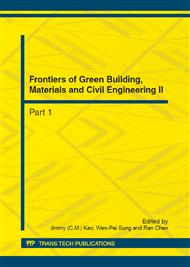p.423
p.427
p.431
p.435
p.440
p.444
p.448
p.452
p.458
Sorptivity of Porous Construction Gypsum Plasters
Abstract:
To understand the water transport properties and generally the mass and heat transfer performance, the sorptivity of different building gypsum plasters are investigated by experiments. The sorptivity of five kinds of gypsum materials are measured and compared with that of fired clay brick. The effects of water/plaster ratio, wet/dry cycles and lightweight additives on the absorbing properties are investigated. The “square root of t” law and the validity of sharp water front (SWF) model are also analysed. It is concluded that the absorption properties of gypsum plasters are sensitive to premixed lightweight aggregates, water/plaster ration and wet-dry cycles
Info:
Periodical:
Pages:
440-443
Citation:
Online since:
August 2012
Authors:
Price:
Сopyright:
© 2012 Trans Tech Publications Ltd. All Rights Reserved
Share:
Citation:


